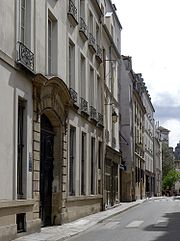This article needs additional citations for verification .(October 2020) |
 View of buildings in the Rue Beautreillis | |
| Length | 231 m (758 ft) |
|---|---|
| Width | 10 m (33 ft) |
| Arrondissement | 4th |
| Quarter | Le Marais |
| Coordinates | 48°51′10″N2°21′48″E / 48.852641°N 2.363310°E |
| From | Rue des Lions-Saint-Paul |
| To | Rue Saint-Antoine |
| Construction | |
| Completion | 1836 |
| Inauguration | 1555 |
The Rue Beautreillis is a street in Le Marais, a historic area of the 4th arrondissement in central Paris, France. [1]
Contents
- Location and access
- Origin of the name
- History
- Notable buildings and events
- Notes and references
- External links


